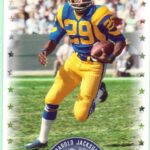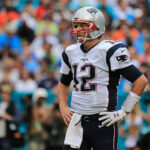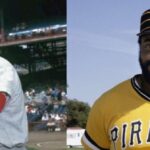Roger Federer’s High Five; Can He Make It Six In A Row?
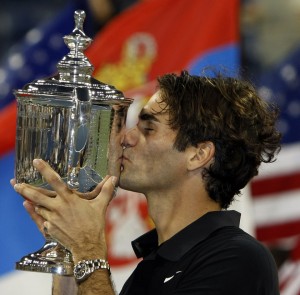
Roger Federer hopes to kiss the U.S. Open trophy for a sixth straight year in 2009.
Introduction
From 2004-2008 Roger Federer won the U.S. Open in New York. Within the confines of Arthur Ashe Stadium Federer has won his last 35 matches in a row during what many call the toughest tournament in tennis.
Once the US Open begins this year, Federer seeks to extend his record winning streak with a record sixth consecutive US Open title.
After winning the 2009 French Open and Wimbledon, the Swiss regained the top ranking. Federer compiled a total of 15 grand slam wins – more than any other male tennis player.
Federer has only lost four matches ever at the US Open. Since Andre Agassi has retired, the only active ATP Tour players to defeat Federer at the U.S. Open are Juan Carlos Ferrero of Spain, Max Mirnyi of Belarus and David Nalbandian of Argentina.
In his U.S. Open debut in 2000 after turning professional in 1998, Federer lost to Ferrero in the third round; then he lost to Agassi (2001), Mirnyi (2002) and Nalbandian (2003) in the fourth round.
Federer got revenge against Agassi with victories at the U.S. Open in 2004 and 2005. In 2005, Federer also would defeat Nalbandian.
But the Swiss is yet to score a New York rematch versus Mirnyi, who has retired from singles competition, or Ferrero.
2004
U.S. Open Roger Federer vs. Lleyton Hewitt 6-0, 7-6, 6-0.
2004 was a great year for the young man from Switzerland. Winning the U.S. Open capped it off in fine style. It was Federer’s 9th title of the year and his 20th title overall – his fourth career grand slam.
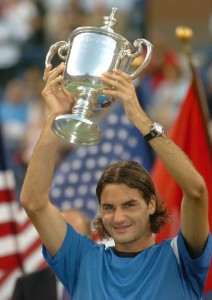
Federer won his first U.S. Open in 2004 defeating Leyton Hewitt.
Lleyton Hewitt, the 2001 champion, was at his fiery finest as he beat the 22-year-old Swede Joachim Johannson 6-4 7-5 6-3 at Flushing Meadows making only 14 unforced errors and facing only one break point.
Johansson, who overcame defending champion Andy Roddick in the semis, produced flashes of brilliance serving 17 aces; but he was never allowed to find his best form. Hewitt was relentless and broke Johannson once in each set.
Hewitt went into Sunday’s final looking secure. He had not lost a set so far in the tournament and had endured only one tiebreak. Hewitt made few unforced errors, returning Johansson’s best shots back with interest, maneuvering his tall opponent deftly around the court.
But his match against Federer proved to be an unending nightmare for Hewitt because the world number one was at times unplayable and withstood a Hewitt fight-back.
Hewitt came into the final on a 16-match winning streak but Federer took control with a stunning first love set. A tight match had been expected but Federer came out in blistering form, dominating with his forehand and racing through the opening set in 18 minutes
Hewitt battled superbly in the second but faltered in the tie-break, and Federer powered through the third for his fourth Grand Slam title.
Federer became the first man in history to win his first four Grand Slam finals and the first man since Mats Wilander in 1988 to win three Grand Slams in a year, following victories in Australia and at Wimbledon.
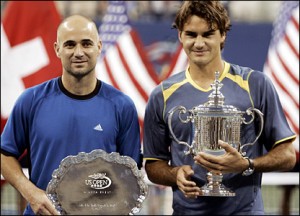
The 35-year old Andre Agassi was no match for Federer at the 2005 U.S. Open
2005
U.S. Open 2005 – Roger Federer vs. Andre Agassi 6-3, 2-6, 7-6, 6-1
Roger Federer remarked that his U.S. Open victory over Andre Agassi in 2005 was the best of his six grand slam victories.
Federer triumphed 6-3 2-6 7-6 (7-1) 6-1 to retain his title, and confessed: “This is the most special one for me, to play Andre in the final of the US Open.
“He’s one of the only living legends in tennis we still have.”
Federer had defeated the 35-year old Agassi 8 times in a row; but the world number one said he still relished the battle that allowed him to win an incredible 23 straight finals.
At 35, Agassi was the oldest finalist since a 39-year-old Ken Rosewall won just two games in losing to Jimmy Connors in 1974.
The man from Las Vegas must have feared a similar fate early on when the Swiss Maestro settled easily into his typical smooth rhythm.
Federer broke Agassi in game six and, after missing seven set points, eventually clinched the opening set. Federer seemed to breathe easier.
Agassi, however, was not going down without a fight and he broke Federer immediately in the second set with some heavy returning, saving three break points on his way to clinching the second set.
The crowd was wildly behind Agassi. Finally, it seemed Federer was there for the taking, and the American went 4-2 up in the third set on his third break-point chance.
Federer was not capitulating. For Agassi the task of capitalizing on chances against the Swiss was another matter. That became readily apparent as Federer hit back immediately.
Federer failed to convert four break points in the heart-stopping eleventh game but, with the match hanging in the balance, the Swiss found his best form to win the tie-break 7-1.
Agassi was done. His last chance disappeared and he went down swinging under a barrage of Federer winners. Federer finished the match on his third Championship point with a winning serve – shouting to the heavens as he celebrated winning another major title.
2006
2006 U.S. Open Championship Roger Federer vs. Andy Roddick 6-2, 4-6. 7-5, 6-1.
Happily Roger Federer promised there would be more Grand Slam success in the future after defeating Andy Roddick 6-2, 4-6, 7-5, 6-1 in the 2006 U.S. Open final.
It was Federer’s third straight U.S. Open title and his ninth Grand Slam, putting him sixth on the all-time winners list.
He became the first man in the Open era to win three successive Wimbledon and U.S. Open titles in the same years.
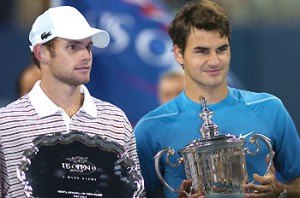
It took four sets for Federer to defeat Andy Roddick in 2006.
That Federer started out superbly was no surprise since he held a 10-1 career record against Roddick. Racing to a 4-0 start, Federer dropped his serve in game seven, but broke again to take the first set.
The American fought back showing he was tougher than he appeared by breaking Federer immediately in the second set and using his huge serve to take the set.
The third set proved critical and the level of the match intensified. Roddick pushed Federer to the brink and provided as much excitement as the crowd had witnessed in the past three years at Flushing Meadows.
The American had four break points in game five but could not convert any, netting a forehand on his best opportunity. Roddick then saved five break points in the next spectacular game and the belief surged through him.
With the New York crowd fully engaged, Federer remained calm – almost stoic throughout. As is his custom, Federer raised the level of his game when it counted, breaking Roddick with a backhand pass in game 12 to take the pivotal third set.
With Roddick’s spirit finally broken, Federer rocketed through the fourth set, providing the assembled 23,000 spectators a master class in tennis as he wrapped up a victory in two hours 26 minutes.
Federer even had to withstand the pressure of golf’s world number one, Tiger Woods, watching him at court-side in Arthur Ashe Stadium.
Roddick was realistic after losing for the 11th time in 12 meetings with the world number one.
“He’s the best player in the game. There’s no question in my mind or if you ask any player about that.”
2007
US Open Final 2007 Roger Federer vs. Novak Djokovic 7-6, 7-6, 6-4
The defeat may have been in straight sets but the young Serb had his chances. Roger Federer trailed by a break in each set but Djokovic failed by faltering at key moments in his first Grand Slam final.
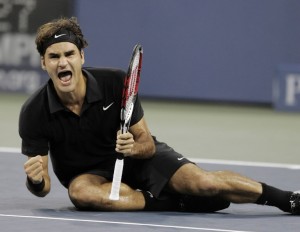
Federer rolled past Novak Djokovic at the 2007 U.S. Open.
Djokovic missed a total of seven set points but Federer resurrected something near top form in the crucial tie-breaks.
Federer seemed particularly nervous as the match got underway. His usually reliable forehand let him down – finally in game 11 he suffered the first service break of the day.
But Djokovic could not rise to the occasion and even after he went up 40-0 building three set points, the young Serb could not close it out. He ended up allowing five set chances to go wanting. Federer evened the score and they headed for a tiebreak.
Federer took full advantage as Djokovic lost his mini-break lead in the tie-break and then double faulted at set-point down.
It was devastating to lose the first set but the young Serb quickly put it behind him and promptly broke first in the second set – Federer could not seem to turn the tourniquet tight enough to stop bleeding errors.
Djokovic could not find his way to the finish line, again. Federer broke the Serb’s serve at love in game seven.
In the twelfth game, two more set points were lost, one with a Federer ace and the second when a backhand landed long by a miniscule fraction.
In the second tie-break Federer’s form returned and the Swiss served superbly and followed his impeccable placement with successive forehand and backhand winners.
Djokovic had many more chances in the third set. In the fifth game he held a 0-40 lead and three break points but again the young Serb failed to convert and he let Federer off the hook again.
The stress and the constant pressure drained the Serb and he began to grow weary. Finally Federer did not have to work too hard to stay in front.
And a lone break at the end of the third was enough to give Federer the 12th Grand Slam title of his career.
He became the first man ever to win Wimbledon and the US Open for four years in a row, and the first to win four straight US titles since Bill Tilden in 1923.
Tilden went on to win six consecutive US Opens and few would bet against Federer, 26, matching that run.
“I think straight sets was a bit brutal for Novak, to be honest,” said Federer. “He deserved better than that. He’s had a fantastic run, not only this tournament but the entire year.”
2008
2008 US Open Final Roger Federer vs. Andy Murray 6-2 7-5 6-2
After a year that seemed rooted in agony and defeat, Roger Federer was in tip-top form winning his fifth straight US Open title and ending Andy Murray’s dreams of dancing down Broadway wearing his first Grand Slam crown.
Murray had hoped to become the first British man since Fred Perry in 1936 to win a major singles title, but he was outclassed by the man who owns the Big Apple.
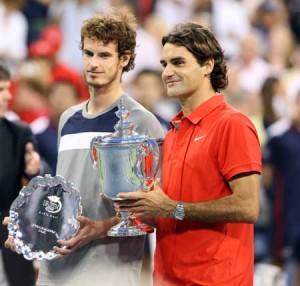
Many believe that Federer and Andy Murray will meet in the finals again in 2009.
Federer rocketed to a 6-2 7-5 6-2 victory in one hour 51 minutes at Flushing Meadows, giving him his lucky thirteenth Grand Slam title – one fewer than held by American Pete Sampras
Federer joined Sampras and Jimmy Connors as a five-time winner of the U.S. title in the Open era. Neither Sampras nor Connors won in five successive years; although fellow American Bill Tilden managed the feat in 1924.
Murray, playing in his first Grand Slam final, entered the match on the back of a first-ever win over world number one Rafael Nadal.
But Federer stepped up to the plate and took it to the lanky Scot whose confidence took a beating meeting the Swiss maestro on a court where he never lost.
Failure was no longer an option for Federer, having lost his number one ranking and his coveted Wimbledon crown. He would take New York to steady his faltering ship.
Federer arrived on court with his best game in tow. He had handed Djokovic a sound thrashing in the semifinals and Federer was ready to rumble.
Murray withstood a break point in game three; but he could not repeat the feat two games later. Delivering a double fault and two errors gave Federer the advantage.
As Federer moved out to 4-2 scoring with a tremendous forehand volley on the dead run, Federer’s confidence owned the house. A barrage of winning forehands forced another break of serve in game seven. The set was over in 26 minutes.
Federer opened the second set with an outrageous cross-court forehand in the first game breaking Murray and going up 2-0. He was not letting up on the Scot
But Murray had not fought so hard and waited so long to go out without firing a shot. Federer’s level began to sag a bit in game three of set number two.
Murray let loose with a big cross-court forehand and a powerful backhand that the Swiss could not handle at the net, and the Scot finally won a break of serve. Perhaps too little – too late.
Inevitably the relentless pressure applied by Federer reaped dividends when he broke to love to take the second set in game 12, with a lunging backhand volley, then a successful chip and charge, followed by a thorough smash and a running pass.
Federer, sensing the finish line, turned up the heat another notch – providing irresistible drama as he swept into a 5-0 lead in the third set.
Murray scrambled back and managed to cut the deficit with his second break of the day; but it only put off the inevitable. Finally Federer put the British number one out of his misery on his second championship point, winning an epic rally with a smash that Murray could not return.
“I had a great tournament but I came up against, in my opinion, the best player ever to play the game today,” said Murray.
JA Allen is a regular contributor to Sports Then and Now.
